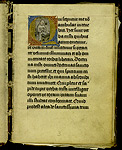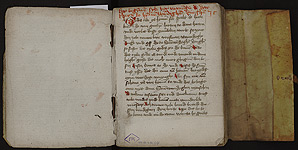Book «The Imitation of Christ» (De imitatione Christi)
Thomas a Kempis (Thomas of Kempen, 1379 / 80-1471) was the most fruitful writer of the «Modern Devotion» movement. He has written several dozen works, the most famous of which is the book The Imitation of Christ (De imitatione Christi). It is the second-most widely read book in the Christian world, next to the Bible. The Imitation of Christ consists of four treatises, which are called books: the Book One - Two- Three - Four. There are approximatly 750 extant manuscript copies of the work, created in the fifteenth century; this allows scientists to call The Imitation of Christ a bestseller of the late Middle Ages. Five of such copies are kept in the National Library of Russia. They are written in different regions of Europe, in different languages, in different author’s versions; books have different compositions, and The Imitation of Christ performed different functions in a collection of texts. The oldest of copies is a tiny booklet of 5,5х7,2 cm in size. Created in 1466 in one of the Benedictine monasteries in Italy, the manuscript contains all four books of The Imitation of Christ, which form one entire work. The second-earliest codex was written in 1469 at the Carthusian monastery Monnikiengenborch in Germany.It includes the Book One of The Imitation of Christ, a treatise on the monastic life and the Book Two of The Imitation. Unlike the previous manuscript, the two books fromImitation of Christ are presented in the Carthusian Codex as two individual works and are separated from one another by an anonymous treatise. The copyist knew the author of the first book, 'There starts a treatise of the brother Thomas a Kempis, a canonic from the monastery of Mount St. Agnes, on the imitation of Christ and contempt of all the vanities of the world'.
As for the second book, the scribe copied it as a work without the author, 'There begin directives for the interior life'.
Thus, in the fifteenth century, the treatises, constituting the book The Imitation of Christ , could lead the existence separately from each other: they were presented as author's and anonymous works in the same book.
In a prayer book created in the late fifteenth century in Cologne, extracts from the text of The Imitation of Christ are arranged so that they form a little didactic introduction. The body of prayers is preceded by a few phrases from the first, second and third chapters of the Book One of The Imitation. The historiated initial «Q» depicts a kneeling monk in prayers. The beautiful grisaille painting, executed in tones of gray, conveys an impression of reverent silence and concentration. The initial precedes The Imitations; the text itself, in turn, serves as an introduction to prayersUsing passages from The Imitation of Christ as a prologue to prayers represents another aspect of the existence of the book.
In addition to the Latin text, there has been dozens of handwritten translations of the manuscript into the main European languages. The National Library of Russia stores two copies of The Imitation of Christ, transcribed in the vernacular in the late fifteenth century.
The Book Four from The Imitation of Christ in the Middle Dutch language is rewritten as anonymous.
The author's name is also not specified in the translation of the Book Three of The Imitation of Christ into the the Middle Low Germen language.
Five manuscript copies of The Imitation of Christ quite fully represent versions of the authorship of the book and its translations, as well as a variety of the purposes, which a text of the work served in the collections of the fifteenth century. Among other works of Thomas a Kempis, the National Library holds The Conversation of the Soul with God (Soliloquium animae ad Deum) and The Small Alphabet of a Monk (Parvum alphabetum monachi in schola dei).




![With how great reverence you should take [the body] of Christ](images/14_sm.jpg)
